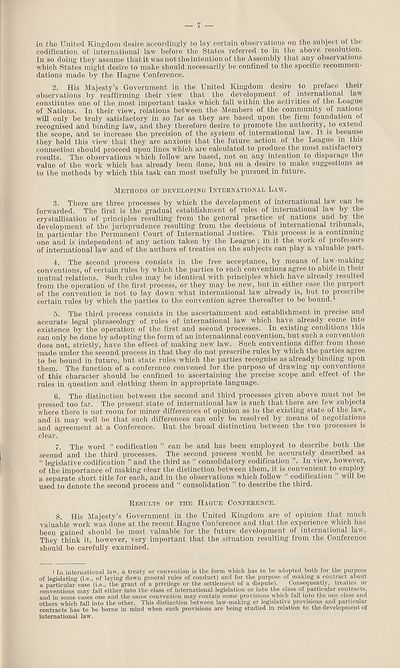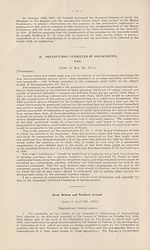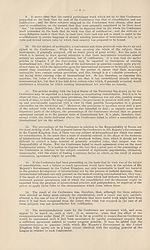Legal > Progressive codification of international law : Observations by the governments : series 1
(7)
Download files
Complete book:
Individual page:
Thumbnail gallery: Grid view | List view

7
in the United Kingdom desire accordingly to lay certain observations on the subject ot the
codification of international law before the States referred to in the above resolution.
In so doing they assume that it was not the intention of the Assembly that any observations
which States might desire to make should necessarily be confined to the specific recommen¬
dations made by the Hague Conference.
2. His Majesty’s Government in the United Kingdom desire to preface their
observations by reaffirming their view that the development of international law
constitutes one of the most important tasks which fall within the activities of the League
of Nations. In their view, relations between the Members of the community of nations
will only be truly satisfactory in so far as they are based upon the firm foundation of
recognised and binding law, and they therefore desire to promote the authority, to extend
the scope, and to increase the precision of the system of international law. It is because
they hold this view that they are anxious that the future action of the League in this
connection should proceed upon lines which are calculated to produce the most satisfactory
results. The observations which follow are based, not on any intention to disparage the
value of the work which has already been done, but on a desire to make suggestions as
to the methods by which this task can most usefully be pursued in future.
Methods of developing International Law.
3. There are three processes by which the development of international law can be
forwarded. The first is the gradual establishment of rules of international law by the
crystallisation of principles resulting from the general practice of nations and by the
development of the jurisprudence resulting from the decisions of international tribunals,
in particular the Permanent Court of International Justice. This process is a continuing
one and is independent of any action taken by the League ; in it the work of professors
of international law and of the authors of treaties on the subjects can play a valuable part.
4. The second process consists in the free acceptance, by means of law-making
conventions, of certain rules by which the parties to such conventions agree to abide in their
mutual relations. Such rules may be identical with principles which have already resulted
from the operation of the first process, or they may be new, but in either case the purport
of the convention is not to lay down what international law already is, but to prescribe
certain rules by which the parties to the convention agree thereafter to be bound.1
5. The third process consists in the ascertainment and establishment in precise and
accurate legal phraseology of rules of international law which have already come into
existence by the operation of the first and second processes. In existing conditions this
can only be done by adopting the form of an international convention, but such a convention
does not, strictly, have the effect of making new law. Such conventions differ from those
made under the second process in that they do not prescribe rules by which the parties agree
to be bound in future, but state rules which the parties recognise as already binding upon
them. The function of a conference convened for the purpose of drawing up conventions
of this character should be confined to ascertaining the precise scope and effect of the
rules in question and clothing them in appropriate language.
6. The distinction between the second and third processes given above must not be
pressed too far. The present state of international law is such that there are few subjects
where there is not room for minor differences of opinion as to the existing state of the law,
and it may well be that such differences can only be resolved by means of negotiations
and agreement at a Conference. But the broad distinction between the two processes is
clear.
7. The word “codification” can be and has been employed to describe both the
second and the third processes. The second process would be accurately described as
“ legislative codification ” and the third as “ consolidatory codification ”. In view, however,
of the importance of making clear the distinction between them, it is convenient to employ
a separate short title for each, and in the observations which follow “ codification ” will be
used to denote the second process and “ consolidation ” to describe the third.
Results of the Hague Conference.
8. His Majesty’s Government in the United Kingdom are of opinion that much
valuable work was done at the recent Hague Conference and that the experience which has
been gained should be most valuable for the future development of international law.
They think it, however, very important that the situation resulting from the Conference
should be carefully examined.
1 In international law, a treaty or convention is the form which has to be adopted both for the purpose
of legislating (i.e., of laying down general rules of conduct) and for the purpose of making a contract about
a particular case (i.e., the grant of a privilege or the settlement of a dispute). Consequently, treaties or
conventions may fall either into the class of international legislation or into the class of particular contracts,
and in some cases one and the same convention may contain some provisions which fall into the one class and
others which fall into the other. This distinction between law-making or legislative provisions and particular-
contracts has to be borne in mind when such provisions are being studied in relation to the development of
international law.
in the United Kingdom desire accordingly to lay certain observations on the subject ot the
codification of international law before the States referred to in the above resolution.
In so doing they assume that it was not the intention of the Assembly that any observations
which States might desire to make should necessarily be confined to the specific recommen¬
dations made by the Hague Conference.
2. His Majesty’s Government in the United Kingdom desire to preface their
observations by reaffirming their view that the development of international law
constitutes one of the most important tasks which fall within the activities of the League
of Nations. In their view, relations between the Members of the community of nations
will only be truly satisfactory in so far as they are based upon the firm foundation of
recognised and binding law, and they therefore desire to promote the authority, to extend
the scope, and to increase the precision of the system of international law. It is because
they hold this view that they are anxious that the future action of the League in this
connection should proceed upon lines which are calculated to produce the most satisfactory
results. The observations which follow are based, not on any intention to disparage the
value of the work which has already been done, but on a desire to make suggestions as
to the methods by which this task can most usefully be pursued in future.
Methods of developing International Law.
3. There are three processes by which the development of international law can be
forwarded. The first is the gradual establishment of rules of international law by the
crystallisation of principles resulting from the general practice of nations and by the
development of the jurisprudence resulting from the decisions of international tribunals,
in particular the Permanent Court of International Justice. This process is a continuing
one and is independent of any action taken by the League ; in it the work of professors
of international law and of the authors of treaties on the subjects can play a valuable part.
4. The second process consists in the free acceptance, by means of law-making
conventions, of certain rules by which the parties to such conventions agree to abide in their
mutual relations. Such rules may be identical with principles which have already resulted
from the operation of the first process, or they may be new, but in either case the purport
of the convention is not to lay down what international law already is, but to prescribe
certain rules by which the parties to the convention agree thereafter to be bound.1
5. The third process consists in the ascertainment and establishment in precise and
accurate legal phraseology of rules of international law which have already come into
existence by the operation of the first and second processes. In existing conditions this
can only be done by adopting the form of an international convention, but such a convention
does not, strictly, have the effect of making new law. Such conventions differ from those
made under the second process in that they do not prescribe rules by which the parties agree
to be bound in future, but state rules which the parties recognise as already binding upon
them. The function of a conference convened for the purpose of drawing up conventions
of this character should be confined to ascertaining the precise scope and effect of the
rules in question and clothing them in appropriate language.
6. The distinction between the second and third processes given above must not be
pressed too far. The present state of international law is such that there are few subjects
where there is not room for minor differences of opinion as to the existing state of the law,
and it may well be that such differences can only be resolved by means of negotiations
and agreement at a Conference. But the broad distinction between the two processes is
clear.
7. The word “codification” can be and has been employed to describe both the
second and the third processes. The second process would be accurately described as
“ legislative codification ” and the third as “ consolidatory codification ”. In view, however,
of the importance of making clear the distinction between them, it is convenient to employ
a separate short title for each, and in the observations which follow “ codification ” will be
used to denote the second process and “ consolidation ” to describe the third.
Results of the Hague Conference.
8. His Majesty’s Government in the United Kingdom are of opinion that much
valuable work was done at the recent Hague Conference and that the experience which has
been gained should be most valuable for the future development of international law.
They think it, however, very important that the situation resulting from the Conference
should be carefully examined.
1 In international law, a treaty or convention is the form which has to be adopted both for the purpose
of legislating (i.e., of laying down general rules of conduct) and for the purpose of making a contract about
a particular case (i.e., the grant of a privilege or the settlement of a dispute). Consequently, treaties or
conventions may fall either into the class of international legislation or into the class of particular contracts,
and in some cases one and the same convention may contain some provisions which fall into the one class and
others which fall into the other. This distinction between law-making or legislative provisions and particular-
contracts has to be borne in mind when such provisions are being studied in relation to the development of
international law.
Set display mode to:
![]() Universal Viewer |
Universal Viewer | ![]() Mirador |
Large image | Transcription
Mirador |
Large image | Transcription
Images and transcriptions on this page, including medium image downloads, may be used under the Creative Commons Attribution 4.0 International Licence unless otherwise stated. ![]()
| League of Nations > Legal > Progressive codification of international law : Observations by the governments : series 1 > (7) |
|---|
| Permanent URL | https://digital.nls.uk/191516365 |
|---|
| Shelfmark | LN.V |
|---|
| Description | Over 1,200 documents from the non-political organs of the League of Nations that dealt with health, disarmament, economic and financial matters for the duration of the League (1919-1945). Also online are statistical bulletins, essential facts, and an overview of the League by the first Secretary General, Sir Eric Drummond. These items are part of the Official Publications collection at the National Library of Scotland. |
|---|---|
| Additional NLS resources: |
|

